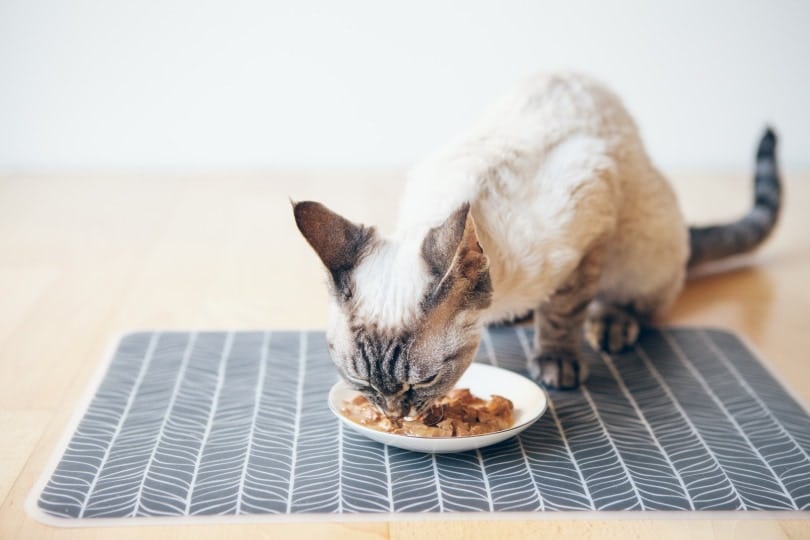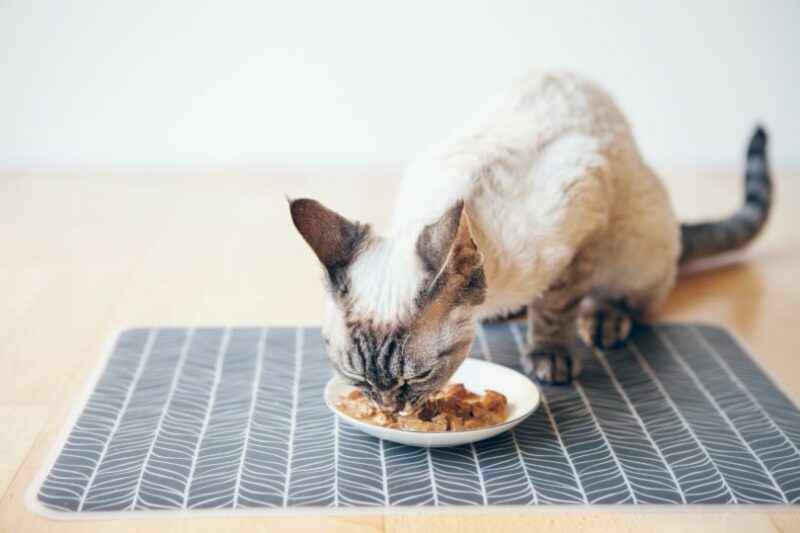Our precious felines are ever so kind to leave us love bombs in the litter box on a regular basis. No matter how many litters you try, it’s hard to mask that smell when things are fresh. So, you might be looking for ways to lessen the load—no pun intended.
Wet food is the oldest kind of cat food we have on the market. So, does it have benefits other than savory flavors and high protein? Wet food may make cats poop less because it has less fiber than grain-filled kibble. However, your cat typically needs more wet food than dry to get the right number of calories each day, which may offset any stool reduction.
Most of the time, your cat will poop once a day on wet cat food—possibly twice. If they are pooping more or less frequently than that, it could be directly related to food changes. Let’s expand on the subject.
A Brief Lesson on Wet Cat Food
Even though cats have been domesticated for centuries, the first commercial foods didn’t appear until the 1900s. The first wet cat food on the market was created in 1922 under the brand name Ken-L Ration.
By 1941, the metal that was originally used to make the cat food cans was extremely sparse. Due to the shortage, people were forced to come up with an idea that would create a longer shelf-life for cat food products.
Even though dry kibble dominated the market for several years, wet food has made a roaring comeback for cats. Today, it’s a favored type of cat food because of the nutritional perks and savory flavors cats love.
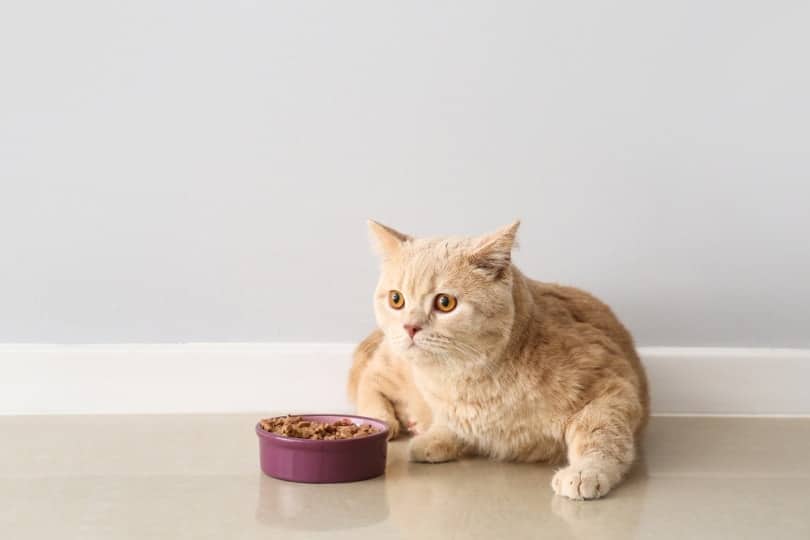
Benefits of Wet Cat Food
Cats really benefit from wet food because it gives them an extra boost of protein and moisture. Domesticated cats sometimes get dehydrated easily because they don’t drink enough.
In the wild, cats get most of their moisture content from the prey they consume. Since domesticated cats are not catching and killing their own prey, it creates a moisture shortage in their systems.
Often, they don’t compensate by drinking more water. So, wet cat food gives your cat a more natural amount of hydration in their daily diet.
How Wet Food Digests
Cats, like humans, have simple stomach structures. Once they consume their food, they process the contents within 10 to 24 hours.
To create a proper schedule, you need to pick set times of the day to feed your cat and stick to it. VCA Hospital recommends that you feed your cat in two increments, splitting up their daily rations into separate meals.
Free feeding, which is filling up a bowl and letting your cat come and go as they please, leads to obesity—even in kittens. So, it’s best to keep your kitty on task with meals instead.
Plus, if you’re feeding your cat wet food, they need to eat the entire helping in a single sitting unless you plan to refrigerate the leftovers. Wet food dries out and spoils quickly once it’s opened.
According to the FDA, perishable food items shouldn’t be left at room temperature for more than 2 hours.
So, once your cat is finished with their wet food, it’s time to store it in the fridge for later.
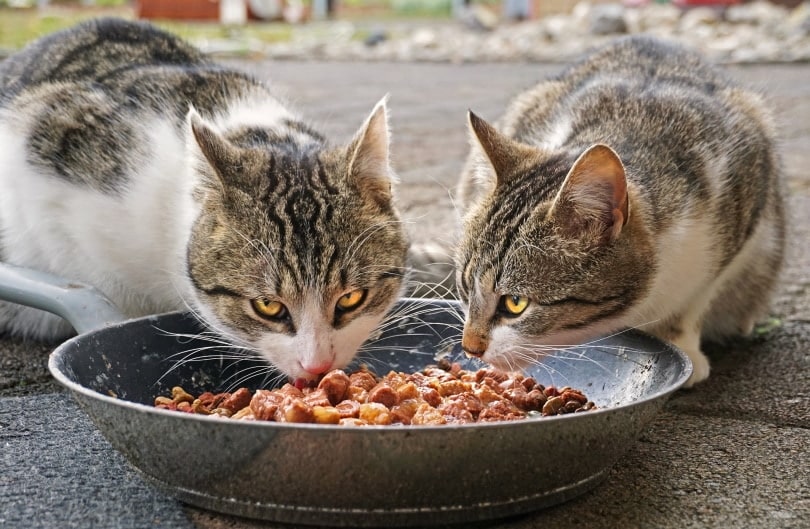
Cats & Litter Box Habits
So, just how much are cats supposed to use the bathroom in a day anyway?
According to Pet MD, your feline friend should eliminate once per day. Any more or less is cause for concern. Granted, twice a day might not raise any eyebrows unless it’s an everyday occurrence.
You can tell a lot about your feline’s health just by observing their bathroom routine and checking on stool consistency. Your cat’s stool should be soft but formed, rather than liquidy or hard.
- Eliminates once a day
- Dark brown
- Firm, soft consistency
- Odorous, but not repugnant
- Eliminates several times per day
- Orange, green, black, or yellow colors
- Watery, loose consistency
- Foul smell
- Eliminates every few days
- Dark brown or green in color
- Hard consistency
- Less smell due to lack of moisture
Why Would Wet Food Make Cats Poop Less?
If you have recently made the switch to wet cat food and it seems like your cat is taking fewer trips to the litter box, it might be due to the decrease in fiber. Dry kibble includes several grains, which are full of fiber. So, despite the fact wet food has much more moisture, it might actually decrease pooping slightly.
Wet Cat Food + Loose Stool
Since wet cat food has a lot of extra moisture, you might wonder if it is going to cause diarrhea or loose stools for your cat. But wet food poses no greater risk of causing loose stool than dry food when served as directed.
However, sudden changes in cat food can cause diarrhea. So, if you recently switched from dry food to wet food, you might notice loose stools for a day or two. Once your cat’s system gets used to this new food, things should even back out again. If it doesn’t, have them evaluated by your veterinarian.
If it’s kibble, wet, or a combination of both that your cat enjoys, choosing the right cat bowl to serve it in goes far beyond presentation. Your cat's comfort is at the forefront with the Hepper NomNom Cat Bowl! The unique design benefits cats in many ways - dual stainless steel bowls are shallow and wide to aid with whisker fatigue and slight elevation for proper posture. The wide catch tray ensures that all food (and water!) stays exactly where you’d expect it to be - inside of the bowl! Click here to learn more. At Catster, we’ve admired Hepper for many years and decided to take a controlling ownership interest so that we could benefit from the outstanding designs of this cool cat company!
Potential Allergies
Some cats may be allergic or have a sensitive reaction to something in the recipe. If it’s a novel protein or contains ingredients they have never had before, you might have triggered a food allergy.
- Skin inflammation
- Itchiness
- Yeast or ear infections
- Hair loss
- Vomiting or diarrhea
If you suspect it, it is imperative that you contact your veterinarian for further evaluation.
Is There a Way to Make Your Cat Poop Less? 3 Solutions
Pooping is a natural part of life. Without the ability to eliminate, we wouldn’t be able to remove the waste from our bodies. Regular pooping habits are a sign of a healthy cat. So, the goal shouldn’t necessarily be to make your cat poop less unless there’s a problem.
1. Don’t Overfeed Your Cat
Even though your cat is likely very convincing when they beg for more food, it is super important to only feed your feline the recommended measurements of food per day. Obesity is a real problem among domesticated cats, especially after they have been spayed or neutered.
No matter how much they might pitch a fit, you should feed your cat based on the recommended age and weight listed on the particular brand of cat food you choose.
Also, keep snacking to a minimum. Too many goodies in a day can really pack on the pounds. If you are feeding commercial snacks, they have recommended feeding guidelines on the back of the product so you can get the proper serving information.
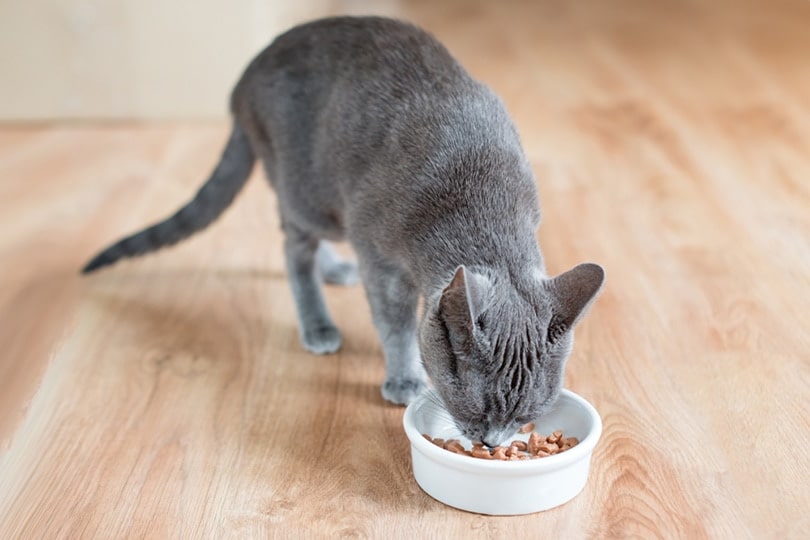
2. Use Supplements
Thanks to the ever-expanding list of products in manufactured cat lineups, there are tons of supplements you can buy for your cat specifically designed for gut and digestion health.
Sites like Chewy have quite a vast selection, but you can always get a recommendation from your vet.
3. Don’t Feed Table Scraps
Table scraps can wreak havoc on your cat’s digestive tract. Cats should not be permitted to eat people food unless it is simply boiled or dehydrated slices of meat.
There are also a ton of awesome grain-filled baked goodies you can try to make yourself. Pinterest has quite a few interesting DIY recipe ideas to create for your kitty.
Regardless of the types of snacks you choose to feed your cat, just make sure you’re not leaving them to have free range of your leftovers.
Conclusion
So, now you know that wet cat food does not have any more of an impact on stool consistency than dry food. However, certain ingredients in the food can cause GI upset.
So, if you worry that your cat is using the bathroom a little bit too much or you’re looking for ways to reduce it, follow the tips we have provided. If you’re concerned about the frequency of your cat’s elimination, speak with your veterinarian to see if other issues need to be addressed.
Featured Image: Veera, Shutterstock

